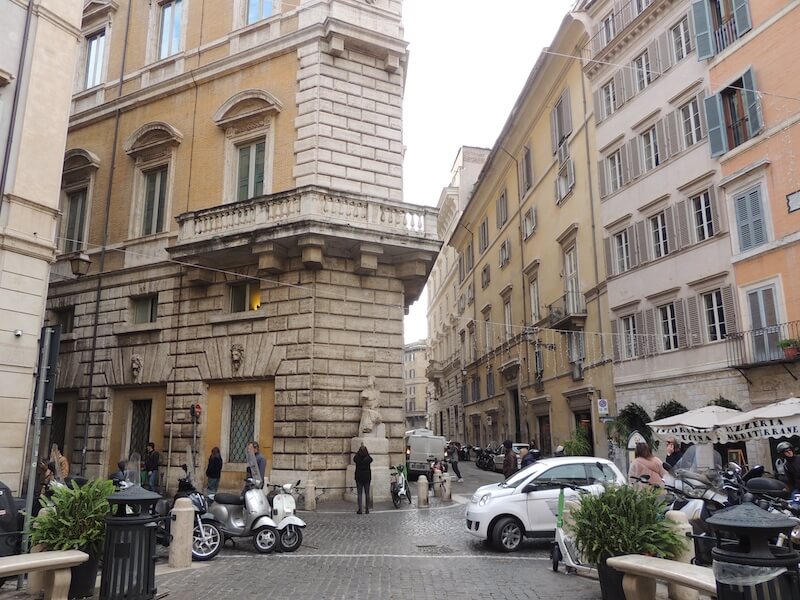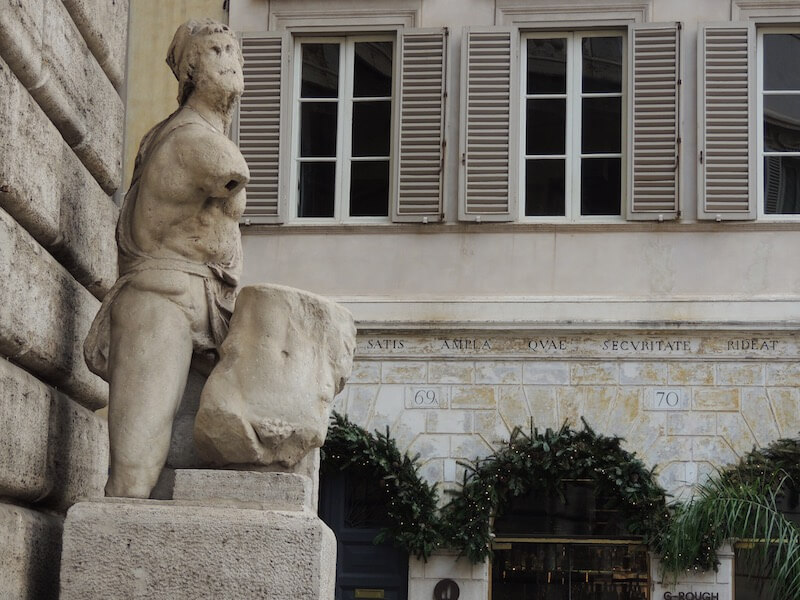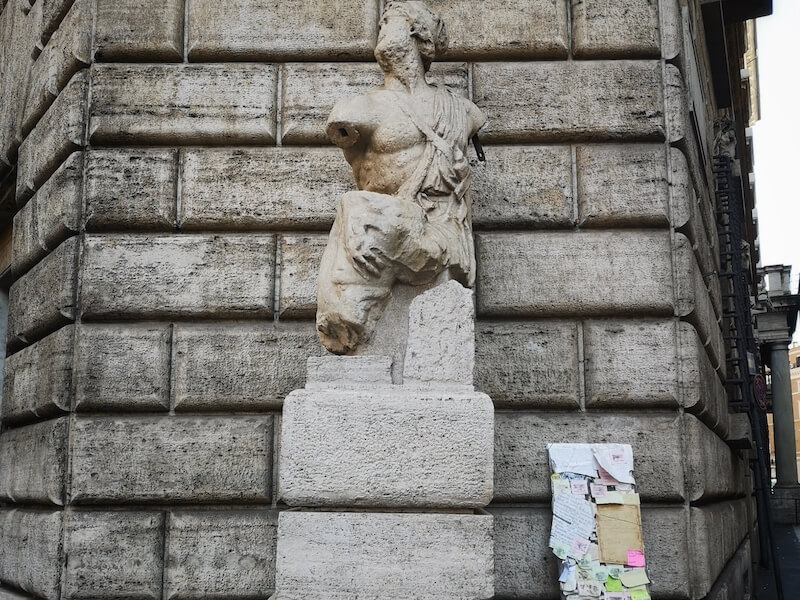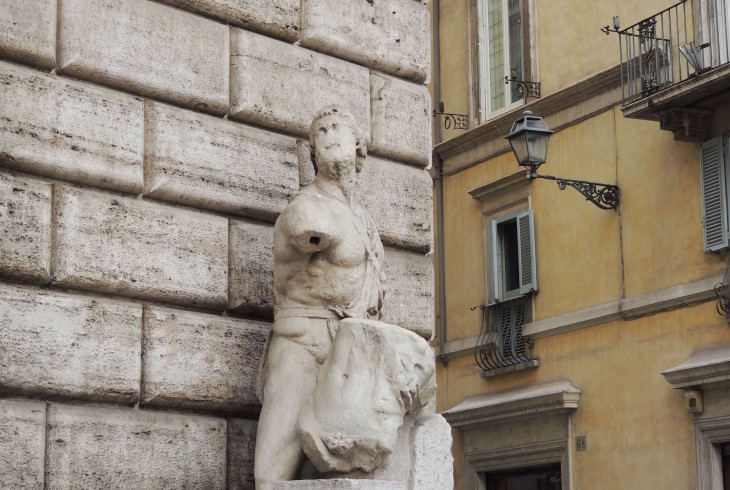Do you know the story of Rome’s speaking statues? Pasquino is a battered ancient sculpture of debatable provenance and disputed subject matter who rose to become the most important member of the city’s ‘Congregation of Wits’ - ancient sculptures that were adopted by the populace in the Eternal City during the early modern period as mouthpieces to express inexpressible political opinions or critiques of the ruling classes via anonymous satirical poems affixed to their plinths.
From his home at the corner of Via del Governo Vecchio near Piazza Navona, Pasquino infuriated the rich and powerful for centuries with his insistence on speaking truth to power; numerous popes became furious with his anonymous critiques, planning to dismember the statue or toss it into the Tiber. All to no avail; the speaking statues continued to speak, and Pasquino is still covered with witticisms and satires to this day.
Find out more about one of Rome’s most fascinating - and least understood - statues with us!
*****

Quod non fecerunt barbari fecerunt Barberini – “What the Barbarians did not, the Barberini did.”
This biting witticism circulated widely in Rome in the 1620s, and refers to a notorious act of state-sanctioned cultural vandalism. Until the 17th century, the porch of the Pantheon was supported by massive bronze roof trusses that had survived intact since antiquity. But finally the lure of the precious metal proved too much for the Barberini pope Urban VIII, who had the bronze stripped out in 1625.
This extraordinary rebuke of the Barberini appropriation and destruction of classical works of art in Rome in order to embellish their own self-eulogizing monuments first surfaced in an anonymous text pinned to the bottom of a fragmented statue, known even then as Pasquino, located just a stone’s throw from Piazza Navona.
The armless statue was discovered in 1501 during the course of building works being undertaken by the great architect Donato Bramante on behalf of the powerful Cardinal Oliviero Carafa, who was having a new palace built in the desirable Parione district of the city. Carafa, a great admirer of Graeco-Roman art, was overjoyed by the discovery, and had the statue placed in the little piazza that faced his palace, where it still stands today. Numerous hypotheses as to the identity of the statue were advanced; some believed it to represent Hercules, whilst other scholars guessed it was Alexander, or even Ajax, one of the mythological heroes of the Trojan war.
Michelangelo saw in it a connection to the story of Menelaus, and believed that the statue portrayed the Mycenaean king holding the dead body of Patroclus as recounted by Homer in the Iliad. Modern scholarship agrees; it seems that the sculpture is most likely a Roman copy of a Greek original, and probably originally adorned the nearby stadium of Domitian, where Piazza Navona stands today.

But why Pasquino? Countless tales concerning the statue’s renaming as Pasquino swirl through the city’s oral history, and lead us variously to a loose-lipped barber and a revolutionary tailor amongst other characters. However, the most popular explanation of the name brings us instead to a teacher who was himself known as Pasquino; according to the tale, the schoolmaster had a habit of getting his pupils to hang Latin epigrams on the statue as a didactic aid. In what was to become an immortal homage, the students applied their teacher’s name to the statue. The name stuck, and the battered marble with the sharp tongue has been Pasquino to generations of Romans ever since.
The Latin teacher’s grammar lessons were just the beginning, however. Humorous satirical rhymes soon appeared stuck to the marble, anonymously recounting the news of the day or rebuking some new abuse perpetrated by the pope and his court - typically delivered with a healthy dose of scurrilous, foul-mouthed and often blasphemous invective. To this day, this unique kind of barbed verse is known as a pasquinade.
The very first recorded pasquinade appeared in August 1501, and was ‘dedicated’ to the Borgia pope Alexander VI, whose shameful antics were legendary. On the Borgia family’s heraldic crest is an ox, a reference to their Spanish origins, and so a nameless writer punned with the words: “Praedixi tibi, papa bos quod esses.” The concise wit of the joke is somewhat lost in translation, but depending on the place of the comma, the meaning of that sentence could be translated as any of the following:
I predicted that you would be an oxen-pope.
I predicted that you, oh pope, would be an ox.
I predicted that you, oh ox, would be a pope.
Pasquino soon graduated to disseminating eloquent indictments of the Church’s leaders, their abuses, and the entire political landscape of Rome. It was a dissidents’ magazine before the age of mass-media, an ingenious way to publicize complaints against the authorities through the medium of an inert marble torso.
The neighborhood where Cardinal Carafa had placed the statue was the most crowded quarter of Rome during the sixteenth and seventeenth centuries. It was where the most famous, noble, and wealthy Roman families had their residences, and it was well connected to the Vatican, where the new home of the Papacy next to Saint Peter’s Basilica was under construction. The area’s aristocratic leanings made it the perfect location to house the dissident, anti-establishment statue. The famous irony and sarcasm of Roman folkloric culture had found its mouthpiece.

Although this marble herald of the people was always under threat of being thrown into the River Tiber, it was spared such an ignominious fate by the illustriousness of its owners, and by the popularity it had gained in the city as a popular icon. When Oliviero Carafa died, numerous influential figures lined up to protect Pasquino from harm; amongst them was the English archbishop Christopher Bainbridge and the poet Pietro Aretino, who was a close friend of the current Medici Pope Leo X.
Pasquinades served as a meaningful and lyrical description of everyday Roman life, with all its gripes, grudges and poetry, for over 350 years. With the arrival of a modern, unified Italian democratic state in the latter decades of the 19th century, the need for a secret outlet of political critique became far less acute. The battle with censorship was largely won, and Pasquino fell mostly silent. Mostly, but not entirely. Now and again the anonymous Roman street poets still spring into action, and if you walk past Pasquino today you never know - you might just see a little note left at his feet!
MORE GREAT CONTENT FROM THE BLOG:
- Everything you Need to Know About Visiting Rome
- How to visit the Colosseum in 2024: Tickets, Hours, and More
- 7 Things you Need to Know About the Trevi Fountain
- Visiting the Vatican Museums and St. Peter's Basilica: The Complete Guide
- 9 Things You Need to Know About the Pantheon in Rome
- 5 Reasons to Explore Italy with Through Eternity
- The Best Catacombs to Visit in Rome
For 25 years, Through Eternity have been organizing itineraries showcasing the best of Rome led by our resident expert guides. If you're planning a visit to the Eternal City this Spring, be sure to get in touch to help plan your perfect trip!

